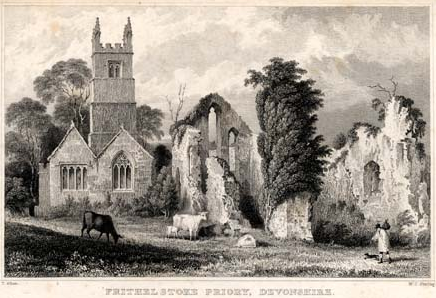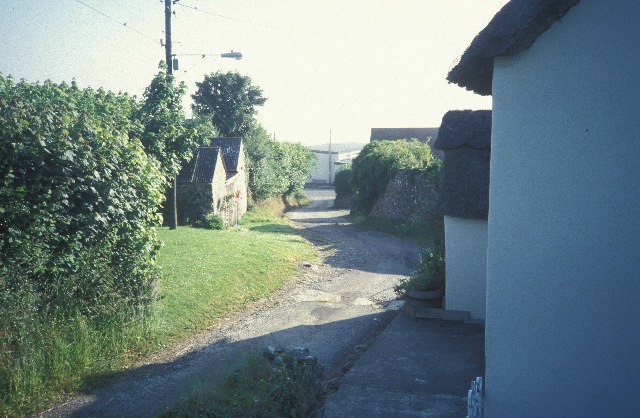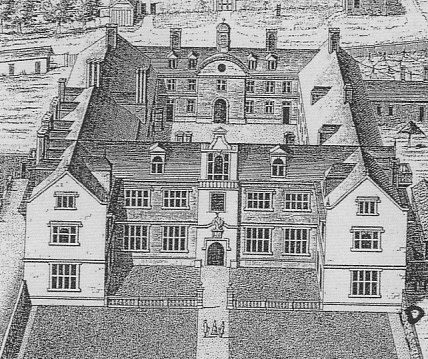|
Frithelstock Priory
Frithelstock Priory was founded in about 1220 at Frithelstock, Devon, England, by Sir Robert de Beauchamp for Augustinian Canons Regular, as an indulgence to ensure intercessions for the repose of his soul. Walter de Stapledon, Bishop of Exeter, is considered a co-founder, for increasing the priory's endowments. The priory was dissolved in 1536 during the Dissolution of the Monasteries and only ruins remain. History The Domesday Book of 1086 lists ''Frelelestoch'' as one of the seventy-nine Devonshire holdings of Robert, Count of Mortain (–1090), the half-brother of William the Conqueror. His tenant was Robert FitzIvo, who appears to have held no other lands in the county. The manor was later held by Sir Roger de Beauchamp who, in about 1220, donated a large part of it to the Augustinian priory dedicated to St Gregory that he had founded within it as a dependency of Hartland Abbey in North Devon. At the Dissolution of the Monasteries, the prior relinquished possession of ... [...More Info...] [...Related Items...] OR: [Wikipedia] [Google] [Baidu] |
Mohuns Ottery
Mohuns Ottery or Mohun's Ottery ( "moon's awtrey"),Gover, J.E.B., Mawer, A. & Stenton, F.M. (1931). ''The Place-Names of Devon''. English Place-Name Society. Vol viii. Part II. Cambridge University Press. p.642 is a house and historic manor in the parish of Luppitt, 1 mile south-east of the village of Luppitt and 4 miles north-east of Honiton in east Devon, England. From the 14th to the 16th centuries it was a seat of the Carew family. Several manorial court rolls survive at the Somerset Heritage Centre, Taunton, Somerset.Somerset Heritage Centre, Taunton, ref DD\HLM/7 Box 7: Deeds for Luppitt, etcCopies of court roll, 1654–1683 and Leases for 99 years and lives, 1628–1763 for properties holden of the manor of Mohun's Ottery, etc./ref> The old manor house burnt down in 1868 and was completely rebuilt as a farmhouse, categorised as a grade II listed building since 1955. The ruins of a mid-16th century gatehouse lie to the south of the house; these and the adjoining garden wa ... [...More Info...] [...Related Items...] OR: [Wikipedia] [Google] [Baidu] |
Petrockstowe
Petrockstowe (or Petrockstow) is a small village and civil parish in the district of Torridge in Northern Devon, England. Its population in 2001 was 379, hardly different from the figure of 385 recorded in 1901. The southern boundary of the parish lies on the River Torridge, and it is surrounded, clockwise from the north, by the parishes of Peters Marland, Merton, Huish, Meeth, Highampton and Buckland Filleigh. The village lies about four miles NNW of the town of Hatherleigh and is some two miles west of the A386 road, accessible only by minor roads. Etymology The place was called Petrocestoua in the Domesday Book in 1086, in 1150 Petrochestona, and in 1202 Petroc. By 1272 it was called Patrichestowe and Petrokestowe in 1297. In 1535 it was called Stowe S"e'i Petroci. All the names mean St Petroc's place, for the patron saint Petroc. Stowe means "place of burial or the shrine of relics of the saint". By 1910, it was also called Padstow. The village is referred to by both sp ... [...More Info...] [...Related Items...] OR: [Wikipedia] [Google] [Baidu] |
Heanton Satchville, Petrockstowe
Heanton Satchville was a historic manor in the parish of Petrockstowe, North Devon, England. With origins in the Domesday manor of Hantone, it was first recorded as belonging to the Yeo family in the mid-14th century and was then owned successively by the Rolle, Walpole and Trefusis families. The mansion house was destroyed by fire in 1795. In 1812 Lord Clinton purchased the manor and mansion of nearby Huish, renamed it Heanton Satchville, and made it his seat. The nearly-forgotten house was featured in the 2005 edition of Rosemary Lauder's "Vanished Houses of North Devon". A farmhouse now occupies the former stable block with a large tractor shed where the house once stood. The political power-base of the Rolle family of Heanton Satchville was the pocket borough seat of Callington in Cornwall, acquired in 1601 when Robert Rolle (died 1633) purchased the manor of Callington.Hunneyball (2010) Description of mansion The mansion was at one time "one of the most imposing house ... [...More Info...] [...Related Items...] OR: [Wikipedia] [Google] [Baidu] |
Margaret Rolle, 15th Baroness Clinton
Margaret Rolle, 15th Baroness Clinton ''suo jure'' (17 January 1709 – 13 January 1781), was a wealthy aristocratic Devonshire heiress, known both for eccentricity and her extramarital affairs. By her first husband Robert, 1st Baron Walpole, later 2nd Earl of Orford (1701–1751) and eldest son of Sir Robert Walpole, she gave birth to a legitimate heir, George Walpole, 3rd Earl of Orford, who succeeded her in the title of Baron Clinton. Family background The only surviving daughter and sole heiress of Samuel Rolle, MP (1646–1719), of Heanton Satchville, Petrockstowe, by his second wife, Margaret, daughter of Roger Tuckfield, of Raddon Court, Devon, a junior branch of the Tuckfield family of Little Fulford, near Crediton, she inherited from her uncle, Roger Tuckfield, MP for the family's pocket borough of Ashburton, following the purchase of the manor of Ashburton in 1702. The Rolle family of Heanton Satchville was a wealthy cadet branch of the Rolles of Stevenstone ... [...More Info...] [...Related Items...] OR: [Wikipedia] [Google] [Baidu] |
Robert Walpole
Robert Walpole, 1st Earl of Orford, (26 August 1676 – 18 March 1745; known between 1725 and 1742 as Sir Robert Walpole) was a British statesman and Whig politician who, as First Lord of the Treasury, Chancellor of the Exchequer, and Leader of the House of Commons, is generally regarded as the ''de facto'' first Prime Minister of Great Britain. Although the exact dates of Walpole's dominance, dubbed the "Robinocracy", are a matter of scholarly debate, the period 1721–1742 is often used. He dominated the Walpole–Townshend ministry, as well as the subsequent Walpole ministry, and holds the record as the longest-serving British prime minister. W. A. Speck wrote that Walpole's uninterrupted run of 20 years as prime minister "is rightly regarded as one of the major feats of British political history. Explanations are usually offered in terms of his expert handling of the political system after 1720, ndhis unique blending of the surviving powers of the crown with the ... [...More Info...] [...Related Items...] OR: [Wikipedia] [Google] [Baidu] |
Robert Walpole, 2nd Earl Of Orford
Robert Walpole, 2nd Earl of Orford, KB (1701 – 31 March 1751), was a British peer and politician, styled Lord Walpole from 1723 to 1745. Origins He was the eldest son of Sir Robert Walpole (1676–1745), the King's First Minister, now regarded as the first British Prime Minister, by his first wife Catherine Shorter. In 1723 his father declined a peerage for himself but did accept the offer on behalf of his 22-year-old son Robert who was thus raised to the peerage as Baron Walpole, of Walpole in the County of Norfolk. Marriage Circa 26 March 1724 Lord Walpole married the 15-year-old heiress Margaret Rolle (1709–1781), the only surviving daughter of Colonel Samuel Rolle (1646–1719), of Heanton Satchville, Petrockstowe. Margaret was the heiress to a junior branch of the great Rolle family of Stevenstone in Devon and to her paternal grandmother, born Lady Arabella Clinton, an aunt and co-heiress of her nephew Edward Clinton, 5th Earl of Lincoln and 13th Baron Clinton ... [...More Info...] [...Related Items...] OR: [Wikipedia] [Google] [Baidu] |
Lisle Letters
The Lisle Papers are the correspondence received in Calais between 1533 and 1540 by Arthur Plantagenet, 1st Viscount Lisle (c.1480-1542), Lord Deputy of Calais, an illegitimate son of King Edward IV and an uncle of King Henry VIII, and by his wife, Honor Plantagenet, Viscountess Lisle (born Honor Grenville and formerly the wife of Sir John Bassett (d.1529) of Umberleigh in Devon), from several servants, courtiers, royal officials, friends, children and other relatives. They are an important source of information on domestic life in the Tudor age and of life at the court of Henry VIII. Although long available as transcriptions in the Letters and Papers of Henry VIII, they were first published as an annotated collection in 1981 as a six-volume edition, titled "The Lisle Letters", and an abridged selection in one volume was published in 1983, both edited by Muriel St. Clare Byrne. Description The entire collection, now housed within the State Papers of the United Kingdom at the Nat ... [...More Info...] [...Related Items...] OR: [Wikipedia] [Google] [Baidu] |
Broadwoodwidger
Broadwoodwidger is a village and civil parish in the Torridge district of Devon, England. According to the 2001 census it had a population of 548. The village is just to the north of the A30 road, and is about eight miles east of Launceston in Cornwall, and 13 miles west of Okehampton. Roadford Reservoir, which is also called Roadford Lake, is to the north-east of the village, and the River Wolf passes at the bottom of the hillside on which the village stands. Broadwoodwidger has a church on top of the hill, with views to Brentor and surrounding countryside. There is a village green, phone box, bus shelter and post box. The parish had a small primary school three miles north of the village at Ivyhouse Cross, but it has now been closed down. The church is 15th century, with some 13th-century features such as the tower and chancel. There is also a Norman font, and benches with carvings of curious animals. Broadwoodwidger was from 1876 to 1922 in the Diocese of Truro but was then ... [...More Info...] [...Related Items...] OR: [Wikipedia] [Google] [Baidu] |
Advowson
Advowson () or patronage is the right in English law of a patron (avowee) to present to the diocesan bishop (or in some cases the ordinary if not the same person) a nominee for appointment to a vacant ecclesiastical benefice or church living, a process known as ''presentation'' (''jus praesentandi'', Latin: "the right of presenting"). The word derives, via French, from the Latin ''advocare'', from ''vocare'' "to call" plus ''ad'', "to, towards", thus a "summoning". It is the right to nominate a person to be parish priest (subject to episcopal – that is, one bishop's – approval), and each such right in each parish was mainly first held by the lord of the principal manor. Many small parishes only had one manor of the same name. Origin The creation of an advowson was a secondary development arising from the process of creating parishes across England in the 11th and 12th centuries, with their associated parish churches. A major impetus to this development was the legal exac ... [...More Info...] [...Related Items...] OR: [Wikipedia] [Google] [Baidu] |
Umberleigh
Umberleigh is a former large manor within the historic hundred of (North) Tawton, but today a small village in North Devon in England. It used to be an ecclesiastical parish, but following the building of the church at Atherington it became a part of that parish. It forms however a part of the civil parish of Chittlehampton, which is mostly located on the east side of the River Taw. The manor of Umberleigh, which had its own entry in the Domesday Book of 1086, was entirely situated on the west side of the River Taw and was centred on the Nunnery which was given by William the Conqueror to the Holy Trinity Abbey in Caen, Normandy. The site was later occupied by the manor house of Umberleigh, the present Georgian manifestation of which, a large and grand farmhouse, is known as "Umberleigh House". Next to the manor house in about 1275 was founded Umberleigh Chapel, now a ruin the single remaining wall of which forms the back wall of a farm implements shed. Descent of the m ... [...More Info...] [...Related Items...] OR: [Wikipedia] [Google] [Baidu] |
Sir John Bassett
''Sir'' is a formal honorific address in English for men, derived from Sire in the High Middle Ages. Both are derived from the old French "Sieur" (Lord), brought to England by the French-speaking Normans, and which now exist in French only as part of "Monsieur", with the equivalent "My Lord" in English. Traditionally, as governed by law and custom, Sir is used for men titled as knights, often as members of orders of chivalry, as well as later applied to baronets and other offices. As the female equivalent for knighthood is damehood, the female equivalent term is typically Dame. The wife of a knight or baronet tends to be addressed as Lady, although a few exceptions and interchanges of these uses exist. Additionally, since the late modern period, Sir has been used as a respectful way to address a man of superior social status or military rank. Equivalent terms of address for women are Madam (shortened to Ma'am), in addition to social honorifics such as Mrs, Ms or Miss. Etymol ... [...More Info...] [...Related Items...] OR: [Wikipedia] [Google] [Baidu] |







